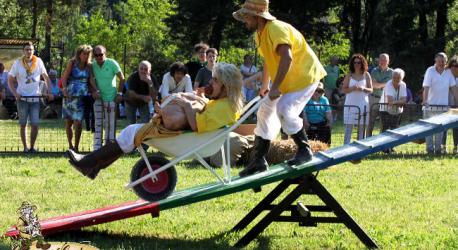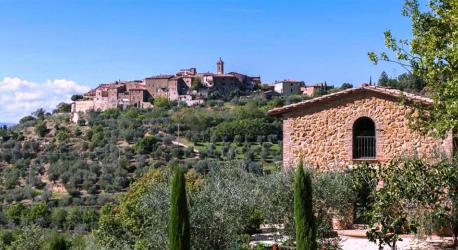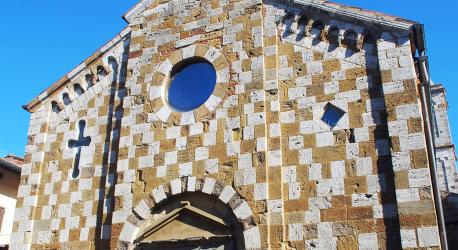"Historic rural landscape of a beautiful and strategic area": The Ministry of Agriculture has assigned this name to the Trequanda area. It certifies its exceptional tourist attractiveness. Immersed in a suggestive bucolic setting, this land is home to one of the most important semi-wild Chianina breed farms. The olive tree is the absolute master of the hills and characterizes them for the excellence of their extra virgin olive oil.
The environmental, touristic and productive quality is testified by the belonging of Trequanda to the association of the Oil Cities and by its awarding of the prestigious Orange Flag of the Touring Club. A pleasant walk along the surrounding hills is enough to realize how the balance and the beauty of this land are the result of a harmony that has been stratified over the centuries between man and nature.
Trequanda is an authentic place, where the lifestyle is linked to traditions and a strong spirituality. In the historic center and in the villages it is still possible today to discover artisans engaged in activities of the past but which are still carried out with pride, such as the processing of terracotta done by hand, with plaster molds, using local clays. The desire to continue forging these artifacts also comes from the need to keep alive the roots of the past, which find expression, for example, in the production of jars to contain oil. However, Trequanda also has a thousand-year history to discover among museums and historic buildings.
Here the Etruscans lived there, of which ancient archaeological finds remain, then in the Middle Ages a village flourished completely enclosed in the walls with three access gates, among which Porta a Sole stands out from which you climb up to the Cacciaconti Castle with its imposing cylindrical tower . Finally, to discover the uniqueness of the area, it is recommended to visit the small villages steeped in traditions and culture such as Petroio or Castelmuzio, which promise to leave tourists speechless.

The celebrations for the blessed Bonizzella Cacciaconti last a few days. On Saturday, the urn with the remains of the blessed is opened and the pilgrimage of the inhabitants of the village begins, followed by Holy Mass, while on Sunday the religious celebrations are scheduled at the church of Saints Peter and Andrew, the procession through the streets of town, bingo in the square and music. The event is enriched by a charity fair and ends with a fireworks display.

A weekend to celebrate rural traditions: the Corrida del Contadino di Petroio finds its strength in a terracotta market exhibition that is enriched by the organization of theatrical performances, music and food stands with handmade pici, grilled meat and local products.

The Olio Novo is one of the products of excellence of the Terre di Siena and is the protagonist of an eagerly awaited feast spread between Trequanda, Castelmuzio and Petroio. Each year a rich calendar of initiatives is planned to raise awareness of the quality and characteristics of this appreciated local product, including food stands, conferences, tastings, market exhibitions and agricultural machinery displays. Entertainment, arts, medieval crafts, falconry, a market, concerts and popular songs accompany the event.

The church dedicated to Saints Peter and Andrew overlooks the main square which houses the remains of Blessed Bonizzella Cacciaconti in a historiated urn of 16th century Sienese art. His body was found centuries after his death, thanks to a swarm of bees that entered and exited from a lateral crack of the church: the stones were removed and the blessed was found emanating a smell of incense. The construction of the current church was started in 1327, and then over the centuries it has undergone various restorations and has taken on the current structure with a bell tower, transept and apse.
Petroio is the village of the “concai” and the terracotta museum proves it. Its rooms collect ancient artifacts of this material and the documentation of traditional processing methods, also placed in connection with the techniques and products of the present. The goal is in fact to preserve this process and pass it on to new generations, especially through the organization of educational workshops where it is possible to manipulate the clay, work with molds and cook the works created.

Castelmuzio is the "living village", with its three hundred inhabitants who look after it and protect it with love and attention. The village, of Etruscan origin but clearly medieval, preserves the fortified castle, the tower and other impressive buildings including the hospital of San Giovanni Battista and the headquarters of the Confraternity of the Trinity and of San Bernardino. It is also worth sitting on the armchairs in the belvedere, a terrace facing Mount Amiata and the Val d’Orcia overlooking the woods and the valley. Just outside Castelmuzio, the parish church of Santo Stefano a Cennano, a Romanesque church from 1285, is worthing a visit.
TheAssociated paths of TREQUANDA






